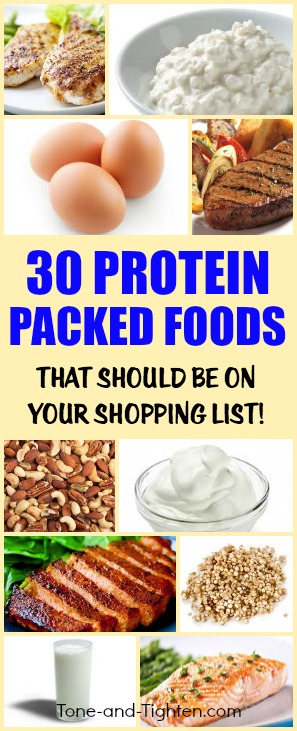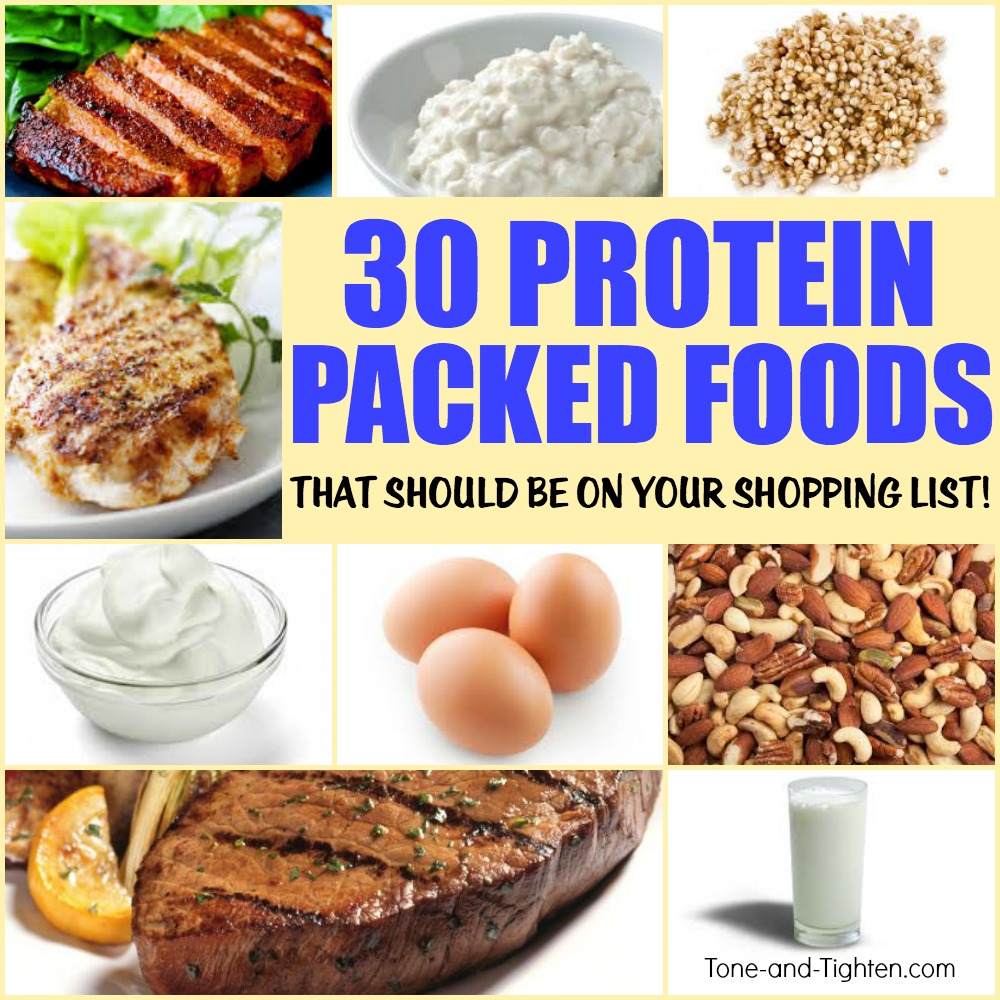Looking for ways to get more high-quality protein in your diet? This list is your answer- the best protein-packed foods that you need. Repair muscle, replete energy sources, and feel healthier with these 30 high-protein foods.
30 of the Best Protein-Packed Foods
Keep reading below for the guide.
===========================
Eliminate guesswork and confusion and start seeing results.
Subscribe to Tone-and-Tighten.com and get our FREE “7-Day Workout and Healthy Menu Plan” delivered daily right to your inbox. CLICK HERE to get it.
===========================
So what’s the deal with protein, anyway? How much should I eat and what are the best sources?
Protein is one of the essential macronutrients (“macros”) that gets a lot of buzz in the health and fitness world. One of the main reasons why is that it’s essential to building and repairing muscle that’s been injured (i.e. after a really good workout).
Protein also plays a role in increasing your metabolism (helping you burn more calories at rest), and ramping up your satiety (you feel fuller longer after you eat a high-protein food). Basically, the more your participate in exercise/fitness, the more important this macro becomes.
But what is the best way to work it into your diet? How much protein should you be eating and which foods are the best sources?
Today I’m answering your questions including a shopping list of 30 of the best protein-packed foods. I also wanted to introduce you guys to my newest nutrition obsession – “The Protein Pantry” from VitaminShoppe.com. It will change the way you get your daily protein forever.
Here we go…
HOW MUCH PROTEIN DO I NEED?
Whenever I’m asked this question I always respond with another question – “What are your goals?” If you do not work out regularly and aren’t doing much strength training then 45-50 grams daily is sufficient for most people.
If you work out regularly (3-5 times / week) with some light to moderate resistance training then approximately 1/2 a gram of protein per pound of bodyweight is sufficient (60-80 grams for a 150 pound person). If your goal is gaining muscle and mass, then the suggested amount is 3/4 – 1 gram of protein per pound of bodyweight, with appropriate strength training.
IS THERE SUCH A THING AS TOO MUCH PROTEIN?
The world is definitely protein-obsessed right now. It’s an amazing nutrient that does great things for our body- but it is possible to eat too much protein.
Most of us typically get enough protein in our diets, and sometimes too much. Your body essentially can’t store extra protein that you eat, plus extra protein gives you extra calories, overworks your kidneys, and can be harmful to your health and diet goals.
It’s all about balance– strive to eat a healthy mix of protein, carbohydrates, and fat to get the nutrients you need to stay healthy.
Quality is better than quantity. Focus on eating high quality protein sources, like the examples from this list, in appropriate serving sizes.
HOW MUCH PROTEIN SHOULD I EAT PER MEAL?
You don’t want to eat all of your protein in one meal, especially on days when you exercise. The most effective way to repair and build muscle is to space your protein intake throughout the day.
Your body can appropriately use about 20-30 grams of protein per meal.
This guide will be helpful for you to have an idea of the amount of protein in some of the foods you eat.
So where do you get all this protein? Below you’ll find a grocery list of the highest protein foods that you can find at the supermarket. I’ve listed the serving sizes with the protein amounts in grams and made it easy for you. Throw these in your cart and work them into your regular diet to watch your gains start to take off.
MEAT
- Chicken Breast – 24 g per 3 oz serving
- Turkey Breast – 24 g per 3 oz serving
- Lean Beef (Steak) – 23 g per 3 oz serving
- Ground Beef (95% lean) – 18 g per 3 oz serving
- Pork Loin Chops – 26 g per 3 oz serving
- Tuna Fish – 25 g per 3 oz serving
- Halibut – 23 g per 3 oz serving
- Salmon – 23 g per 3 oz serving
- Tilapia – 21 g per 3 oz serving
DAIRY
- Non-Fat Mozzarella Cheese- 8g per 1 oz serving (1 slice or about 1/4 cup shredded)
- Milk – 8 g per 1 cup
- Tofu – 12 g per 3 oz serving
- Smoothie drinks – 16 g per 1 cup serving
- Greek Yogurt – 23 g per 8 oz serving
- Cottage Cheese – 14 g per 1/2 cup
- Swiss Cheese – 8 g per 1 oz serving
PRODUCE
- Edamame – 8 g per 1/2 cup
- Green peas – 7 g per 1 cup serving
PANTRY
- Kidney Beans – 43 g in 1 cup serving
- Black Beans – 39 g in 1 cup serving
- Jerky – 13 g per 1 oz serving
- Peanut Butter – 8 g per 2 tbsp serving
- Mixed Nuts – 6 g per 2 oz serving
- Almonds – 6 g in 1 oz serving
- Bean Chips – 16 g per 1 cup serving
- Wheat Germ – 6 g per 1 oz serving
- Quinoa – 8 g per 1 cup serving
- Oatmeal – 6 g in 1 cup serving
FRIDGE/FREEZER
- Soy Milk – 8 g per 1 cup serving
- Frozen Greek Yogurt – 6 g per 1/2 cup serving
Looking for a simple and delicious way to get more quality protein into your diet? Try out some of our favorite protein-packed recipes!
Protein-Packed Turkey and Vegetable Skillet
Be sure to not miss another post. Get more recipes, workouts, and fitness tips- follow Tone and Tighten on Instagram | Facebook | Pinterest | YouTube | Twitter
As always, should you have any questions or comments you can always leave them below or email me at ToneandTightenFitness{at}gmail{dot}com
Make it happen,
Jared



Very helpful and informative
Thanks Kobus!